A delicious Lychee & Pomegranate Pavlova which would be perfect to celebrate the Lunar New Year or any celebration. Recipe with step-by-step photos.

Flower Pavlova
With the Lunar New Year around the corner, I’m always thinking of creative ways to serve dessert. First and foremost, fresh fruit is usually the dessert of choice in many Asian households. Alternatively, there is an array of sweet Asian desserts which, unless you have grown up eating them, can be an unusual texture and/or flavour challenge to many.
As it is usually just me who eats the Asian desserts in my household, I decided one year to combine popular Asian fruits with my favourite Australian dessert – a pavlova – to make a flower-shaped pavlova. The result was a cute and delicious dessert which acknowledges both my Vietnamese and Australian heritage 🙂
The flower shape is a nod to the Tray of Togetherness that is shared with guests around the Lunar New Year, but also a nod to the flowers used to usher in luck and prosperity.
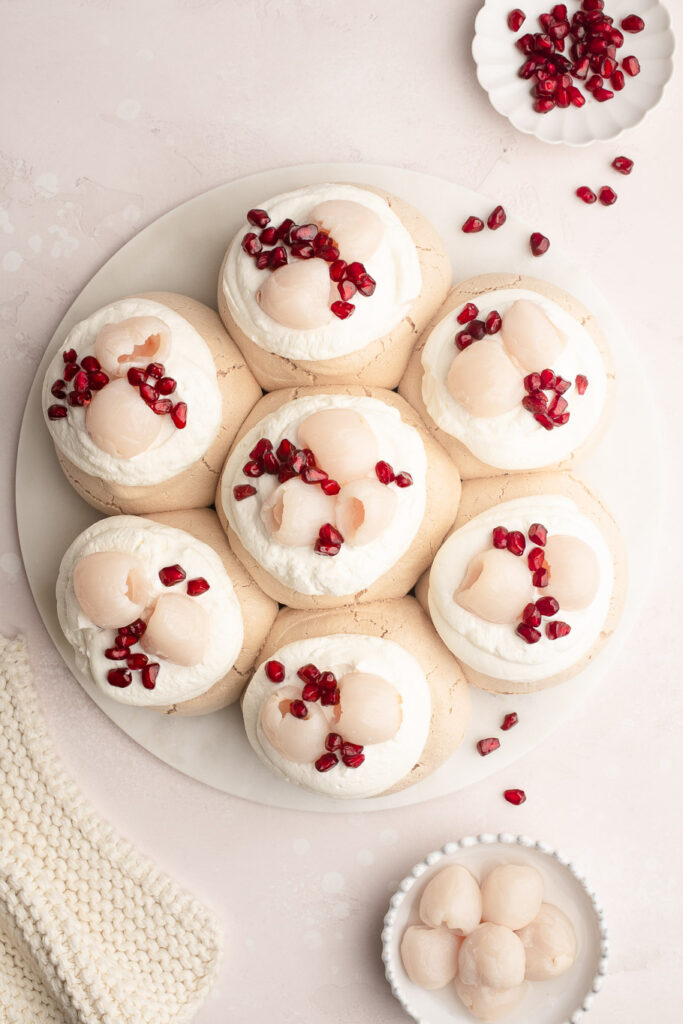
Pavlova Toppings
As a pavlova is essentially a large meringue, it is generally recommended to serve it with something tart to cut through the sweetness. There are, of course, always exceptions. Many of the fruits listed below have a slight tartness or work well in combination with a tart fruit, e.g. lychees with grapefruit.
For an Asian-inspired pavlova, I recommend using one or a combination of the following fruits:
- Lychees, fresh or canned
- Pomegranate seeds (symbolises fertility, longevity and prosperity)
- Pomelo, peeled and cut into segments (symbolises family unity)
- Grapefruit, peeled and cut into segments (symbolises good luck and happiness)
- Oranges, peeled and cut into segments (symbolises good luck and happiness)
- Star fruit, sliced
- Dragon fruit, peeled and sliced (symbolises good luck)
- Mango, sliced
- Passionfruit
Lychee Pavlova
Lychees come into season during the summer months in the sub-tropical countries, including Australia which grows some of the best lychees.
As lychees are only ever imported in Europe, they tend to make an appearance around Christmas and New Year, so many Europeans associate lychees with Christmas – strange but true!
Fresh lychees are an absolute delight. They have a very sweet and delicate flavour, and the fresh lychees can sometimes have a slight sourness to them.
If you can’t find fresh lychees, canned lychees are a perfectly acceptable substitute, although they tend to be much sweeter than fresh lychees because they are often stored in a syrup.
For a Lychee Pavlova, I highly recommend using fresh lychees for that subtle sourness to contrast with the sweet meringue. But if you can only use canned lychees, I recommend pairing it with a sour fruit such as grapefruit or passionfruit.
Pavlova Recipe
My flower pavlova recipe is based on my Classic Pavlova recipe. It is also very similar to my recipe for Christmas Pavlova Wreath, with a slight variation in shaping the pavlova.
When making a flower pavlova, you are, in effect, making small conjoining meringues. So the dessert will be crispier than your usual pavlova, but also easier to serve and portion.
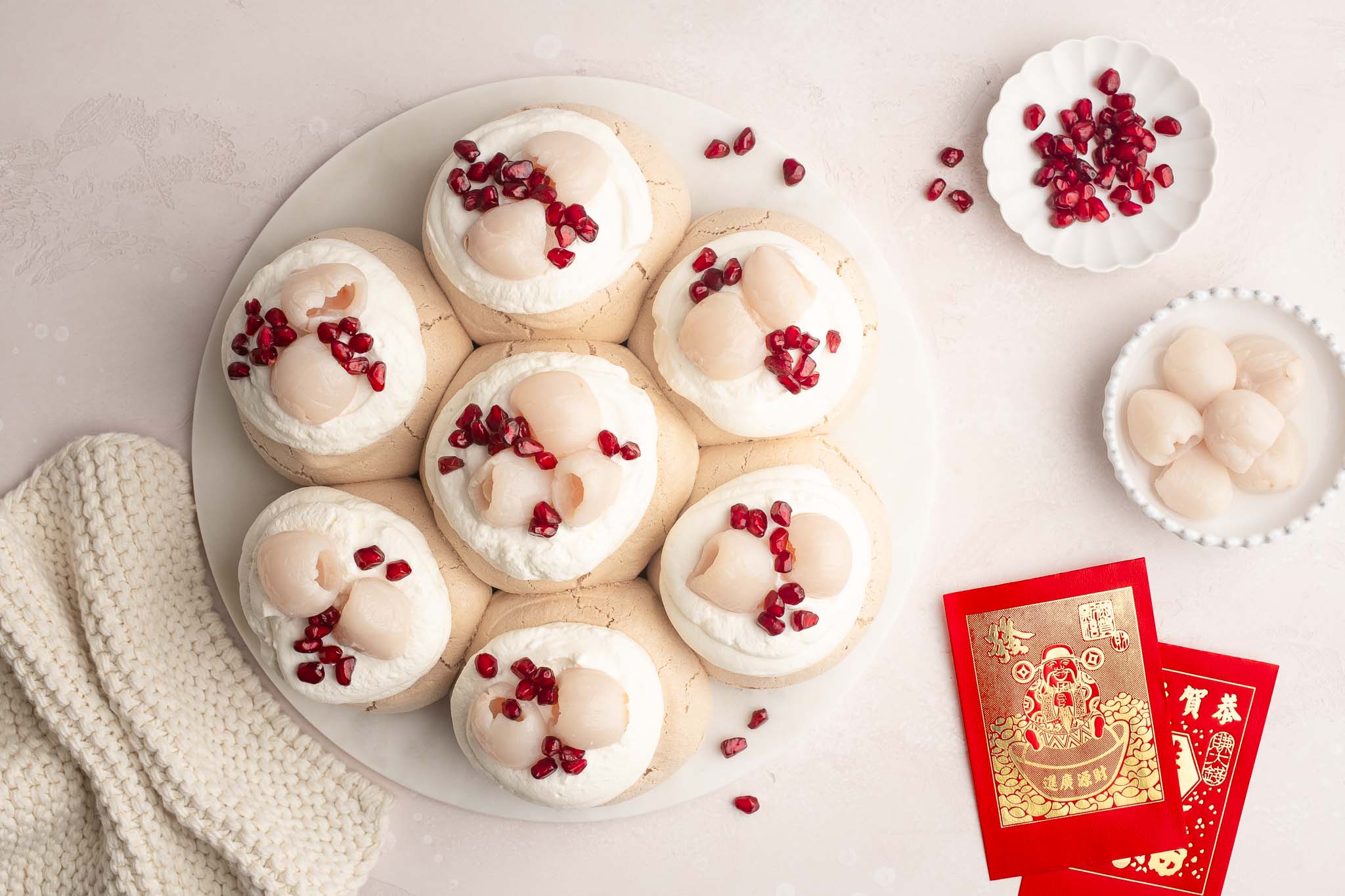
How to Make a Flower Pavlova
Step 1
Unless you really want to have a heavy duty upper arm workout, an electric stand mixer or an electric hand-held beater is an essential equipment when making a pavlova.
Place the egg whites into a large, clean bowl that is free from any grease.
To ensure that the egg whites whip up nicely, make sure that they are at room temperature.
Step 2
Whisk the egg whites until they have tripled in volume and form soft peaks when you lift the beaters.
Soft peaks mean that, when you lift the beaters, the mixture forms a peak which falls over or which does not stand.
At this stage, the beaten egg whites should look very soft and foamy.
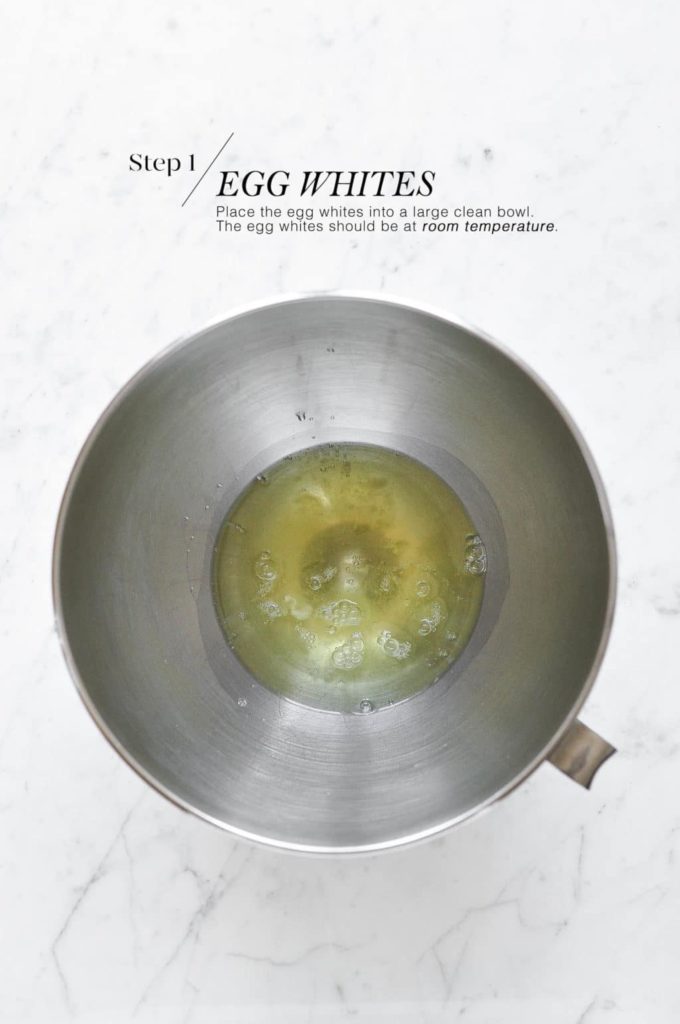

Step 3
Next, add the sugar, one spoon at a time, until the egg whites transform into a thick and glossy mixture, and stiff peaks form when you lift the beaters.
Stiff peaks mean that, when you lift the beaters, the mixture forms a peak which holds its shape.
It is important to make sure that the sugar has been completely dissolved in the egg white mixture, but it is also important to not over-beat the mixture once you start adding the sugar.
To test that the sugar has been completely dissolved, simply rub a bit of mixture in between your finger tips.
Step 4
Add the cornflour, vinegar and vanilla. A few rotations of the stand mixer should be enough to mix in these ingredients.
The resulting pavlova mixture should be thick and firm, and it should hold its shape when you start piling it on the baking tray.
If the pavlova mixture is soft and runny, and you are unable to shape it into a high pavlova because the mixture keeps sliding, it means that you may have overbeaten the eggwhites or that you added the sugar too soon. Please see the FAQs here.
Transfer the pavlova mixture to a large disposable piping bag and cut a tip about 1 cm/0.5 inch wide.
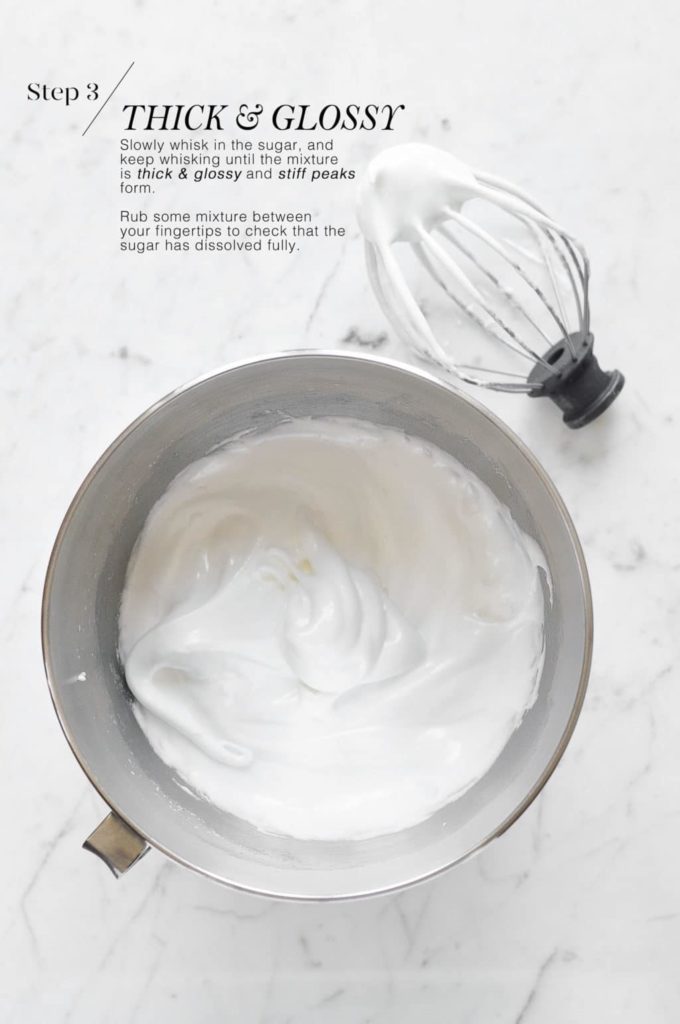
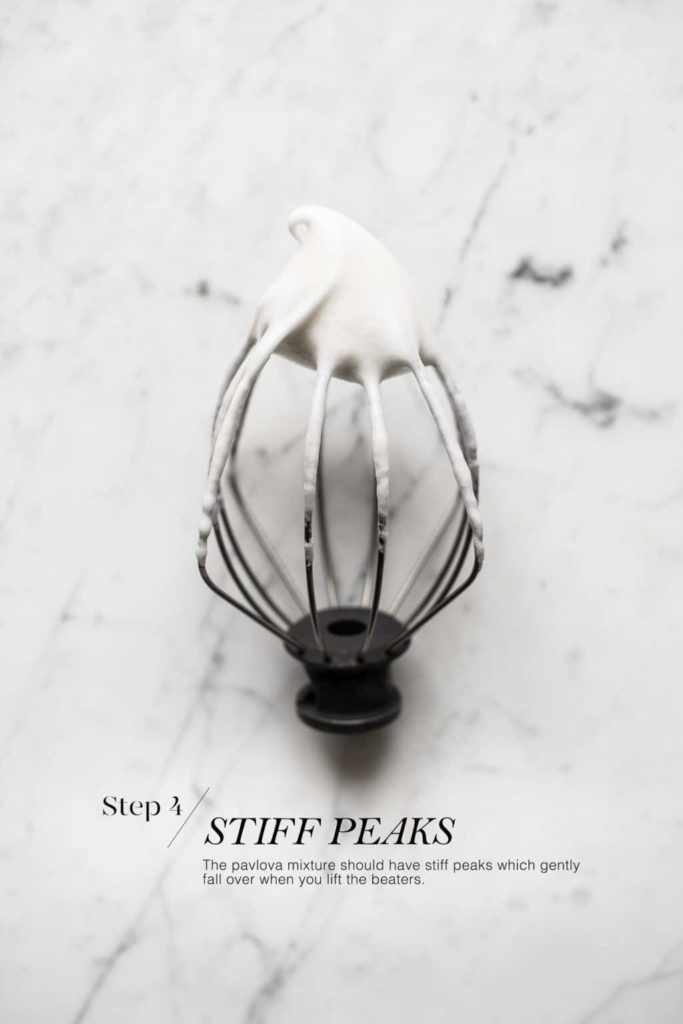
Step 5
Draw a 23 cm/9 inch circle on a large sheet of baking paper. Turn the paper over so that the ink is not touching the pavlova.
Pipe 1 round in the centre of the circle. Then pipe the remaining 2 rounds within the circle at 12:00 and 6:00. Next, pipe the remaining 4 rounds, to form 7 rounds in total.
Try to make each round roughly the same size by piping more mixture into the centre of any existing round.
If you don’t have a piping bag, simply use a large spoon (such as a serving spoon) to make large dollops.
Use a large spoon or offset spatula to smooth the tops of each round, and to even create a crater where the cream will later sit.

Step 6
Place the pavlova into the oven at 180°C/350°F.
Immediately turn down the temperature to 150°C/300°F.
Let the pavlova bake for 1 hour, and do not open the oven door during this time.
After the baking time, turn off the oven, and leave the pavlova to cool inside the closed oven for at least 2-3 hours.
Step 7
Decorate the pavlova just before serving.
Whip the cream until it is thick with soft peaks. Dollop the cream on top of the pavlova, either using a large piping bag or with a large spoon. Decorate with fruit and berries of your choice.
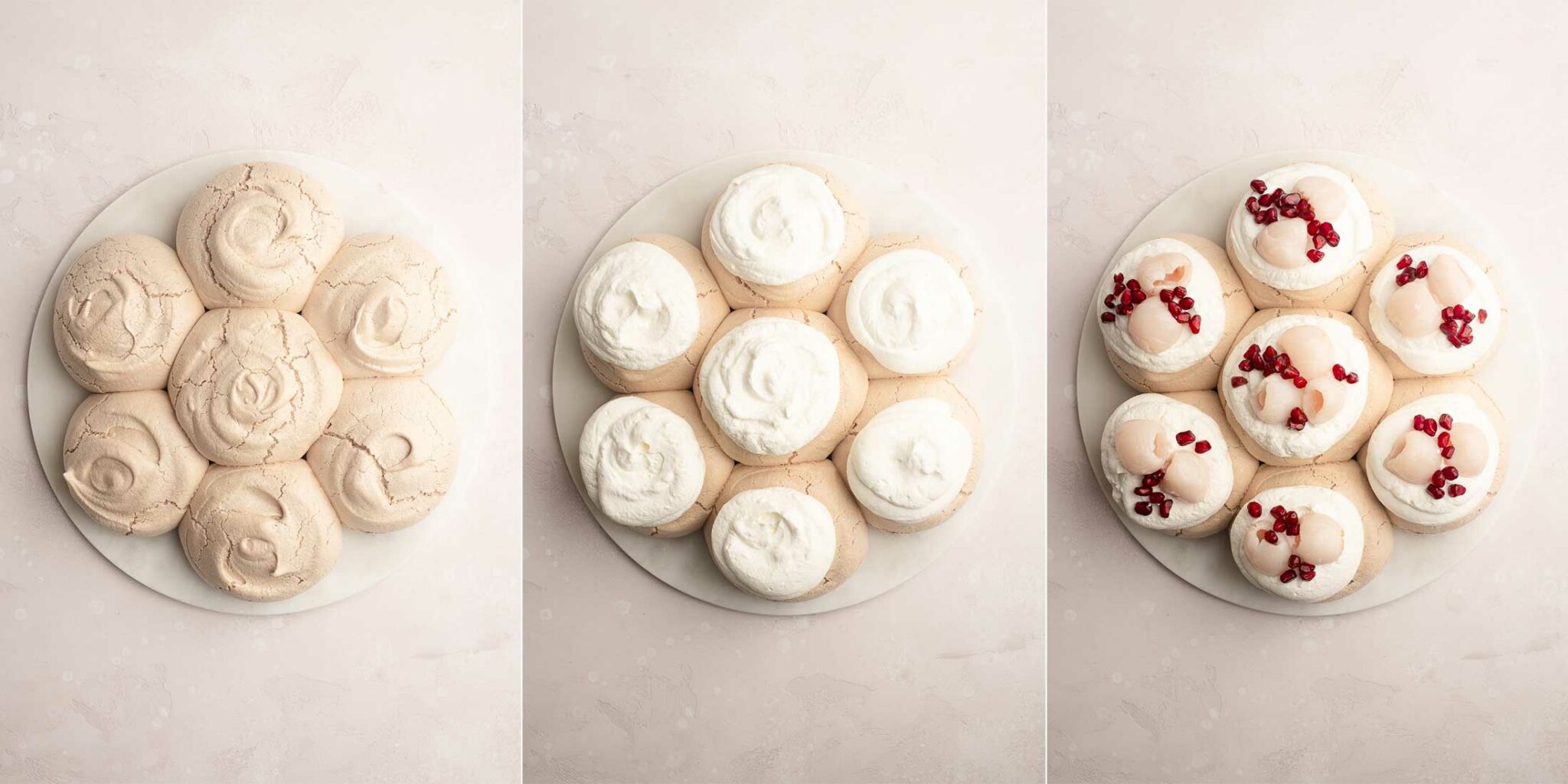
Lychee and Pomegranate Flower Pavlova

- Resting Time: 2 hours
- Prep Time: 30 mins
- Cook Time: 60 mins
- Total Time: 1 hour 30 minutes
- Yield: 4 to 8
- Category: Dessert
- Method: Oven
- Cuisine: Australian
A delicious Lychee & Pomegranate Pavlova which would be perfect to celebrate the Lunar New Year or any celebration. Recipe with step-by-step photos.
Ingredients
For the pavlova
- 4 egg whites
- 240 g (1 cup plus 1 tablespoon) caster sugar (superfine sugar)
- 2 teaspoons cornflour (US: cornstarch)
- 1 1/4 teaspoon white wine vinegar
- 1 1/4 teaspoon vanilla extract or vanilla bean paste
For the topping
- 300 ml (1 1/4 cup) double cream (heavy whipping cream)
- lychees, fresh or canned
- pomegranate seeds
Instructions
To make the pavlova
- Preheat the oven to 180°C/350°F (without fan).
- Using a standmixer or electric beaters, whisk the egg whites in a large, clean bowl until they have tripled in volume and soft peaks form.
- Turn the speed down to low and slowly add the caster sugar, one spoon at a time until the sugar is well incorporated. As you add the sugar, the mixture will start to become thick and glossy, and stiff peaks will form when you lift the beaters.
- Remember to scrape down the sides of the bowl.
- Rub a bit of the mixture between your fingertips to test if the sugar has been fully dissolved; if you don’t feel any grains of sugar, move onto the next step.
- Add the cornflour, white wine vinegar, and vanilla extract. I do this on low speed with the stand mixer for only 2 to 3 rotations (about 1 second).
To shape the pavlova
- Line a baking tray with baking paper.
- Draw a circle on the baking paper measuring 23 cm/9 inches, and then turn the paper over so that the ink does not touch the pavlova.
- Transfer the pavlova mixture to a large piping bag with a large nozzle (or cut a 1 cm tip from a disposable piping bag). Alternatively, use a large spoon to dollop the mixture.
- Pipe 1 large round within the circle. Imagine the circle is a clock, and pipe a round at 12:00 and 6:00. Then pipe 4 rounds in between, so that you have 7 rounds in total.
- Ensure that each round is roughly the same size by squeezing additional mixture in the centre of each round as needed.
To bake the pavlova
- Place the pavlova in the oven and immediately turn the temperature down to 150°C/300°F (without fan).
- Bake for 1 hour. Do not open the oven door during this time.
- After 1 hour, turn off the oven and leave the oven door closed so the pavlova can cool down completely. You should leave the pavlova in the oven for at least 2-3 hours to dry out.
To decorate the pavlova
- The pavlova should be decorated only just before serving.
- Whip the double cream until it is thick and soft.
- Spread the cream over the top of the pavlova.
- Decorate with fruit and berries of your choice.
Kitchen Notes
 MAKE IT IN ADVANCE
MAKE IT IN ADVANCE
I recommend making the pavlova the night before serving, or in the morning if you plan on serving it later in the evening. This will give the pavlova plenty of time to cool and dry in the oven for the perfect crisp meringue shell and slightly chewy centre. You could even make the pavlova 1-2 days in advance and keep it in an air-tight container.
 DECORATE AT THE LAST MINUTE
DECORATE AT THE LAST MINUTE
Although I recommend baking the pavlova in advance, you should only decorate the pavlova at the last minute. Once the cream is placed on the pavlova, it will start to soften the pavlova and add weight, and your pavlova might collapse soon after.
 OVEN TEMPERATURES All recipes on this website state temperatures for a regular oven (i.e. a conventional oven without fan). If you have a convection oven with a fan, please consult the manufacturer’s handbook on how to adjust the temperature and baking time accordingly.
OVEN TEMPERATURES All recipes on this website state temperatures for a regular oven (i.e. a conventional oven without fan). If you have a convection oven with a fan, please consult the manufacturer’s handbook on how to adjust the temperature and baking time accordingly.
 CONVERSIONS To convert from cups to grams, and vice-versa, please see this handy Conversion Chart for Basic Ingredients.
CONVERSIONS To convert from cups to grams, and vice-versa, please see this handy Conversion Chart for Basic Ingredients.
 Print
Print Pin Recipe
Pin Recipe Rate
Rate
This pavlova is so beautiful! I decorated it with pomelo and pomegranate. I’m going to make this every Lunar New Year now!